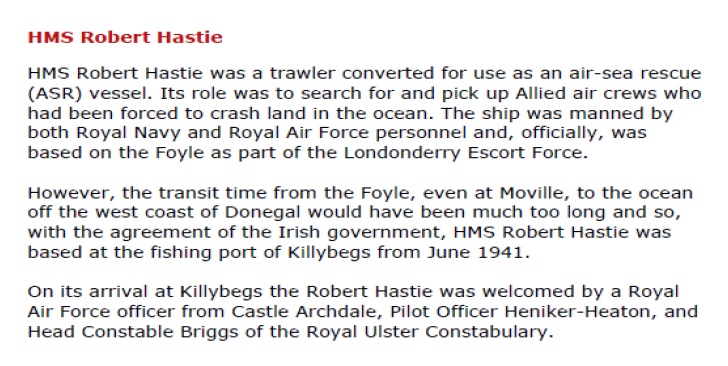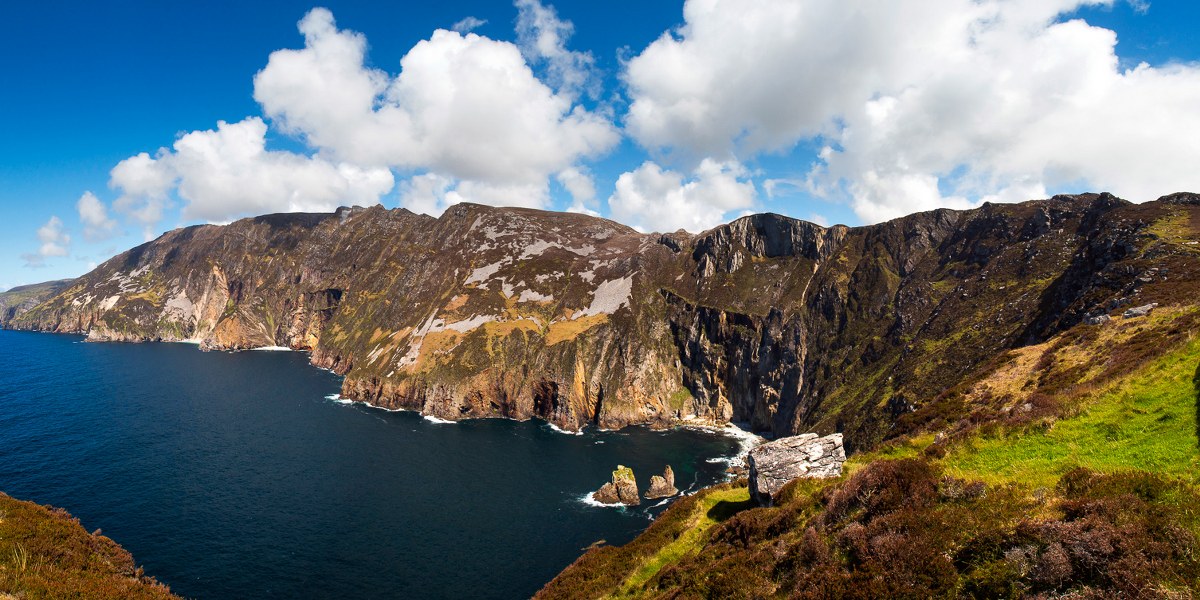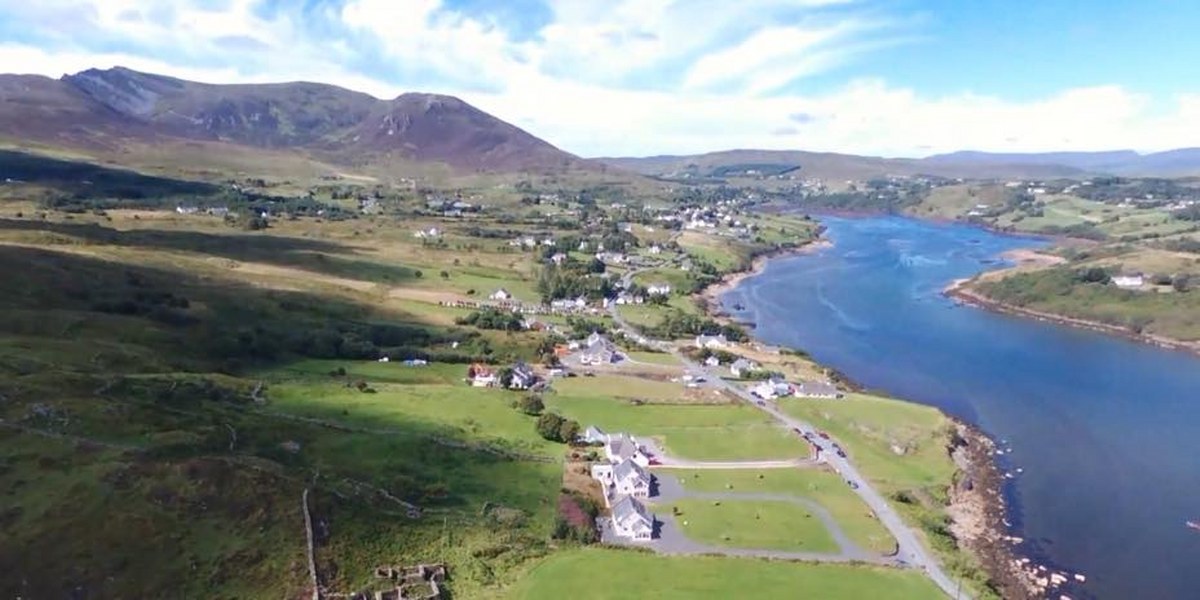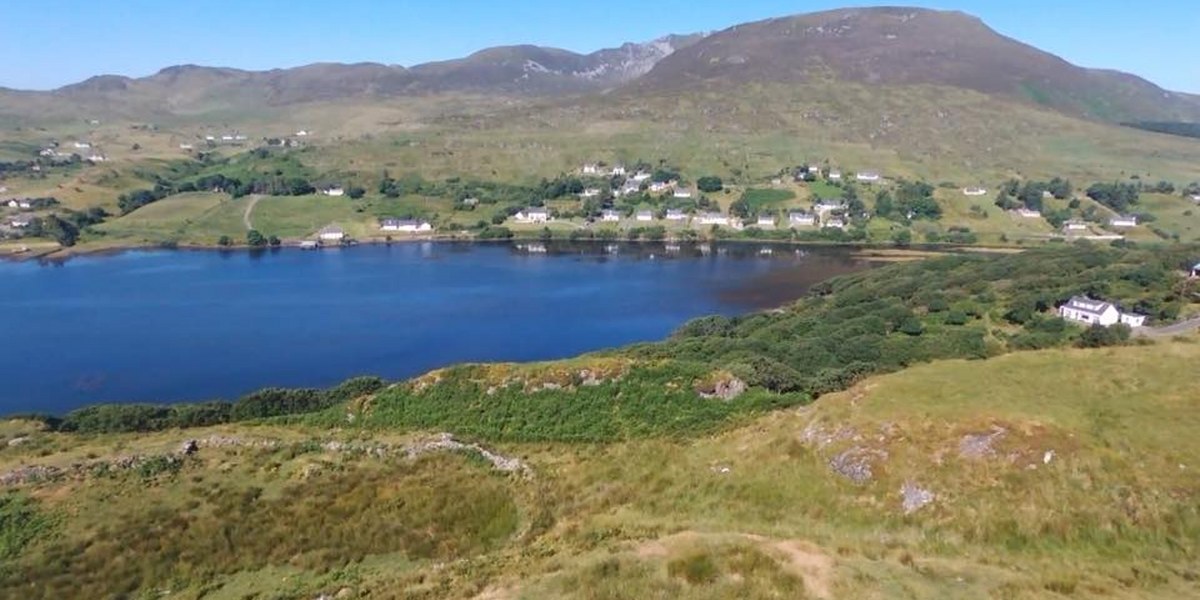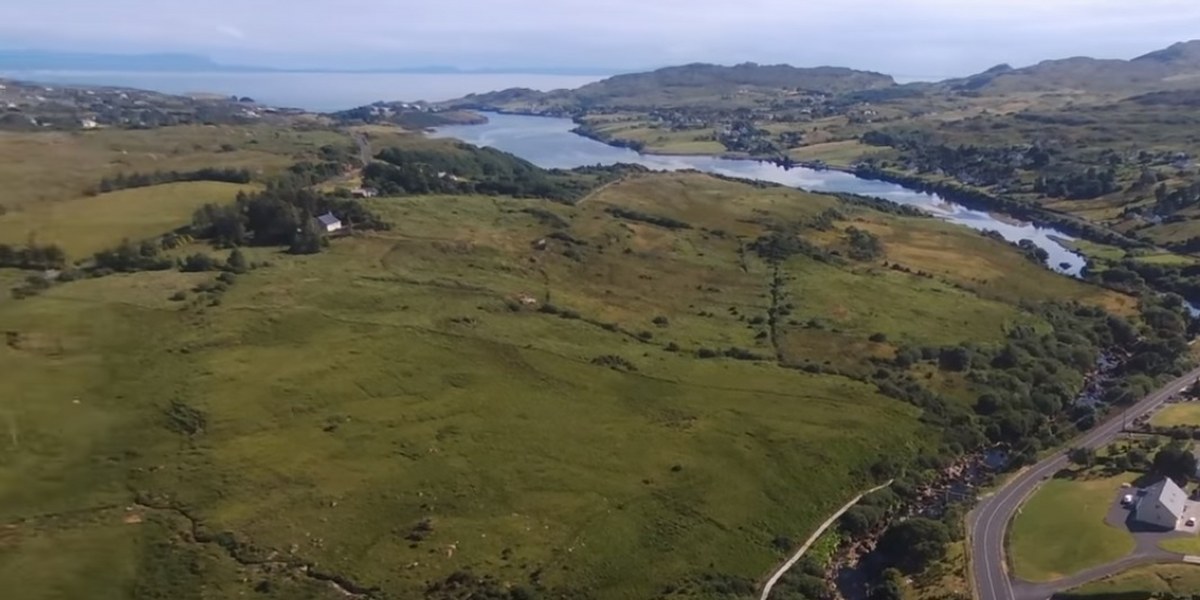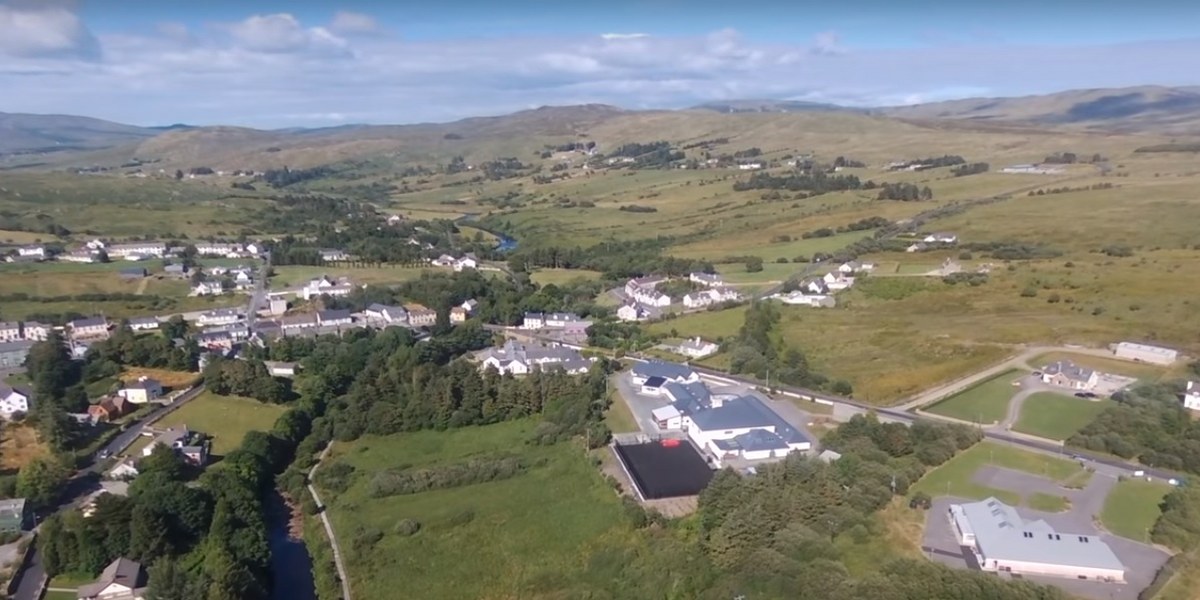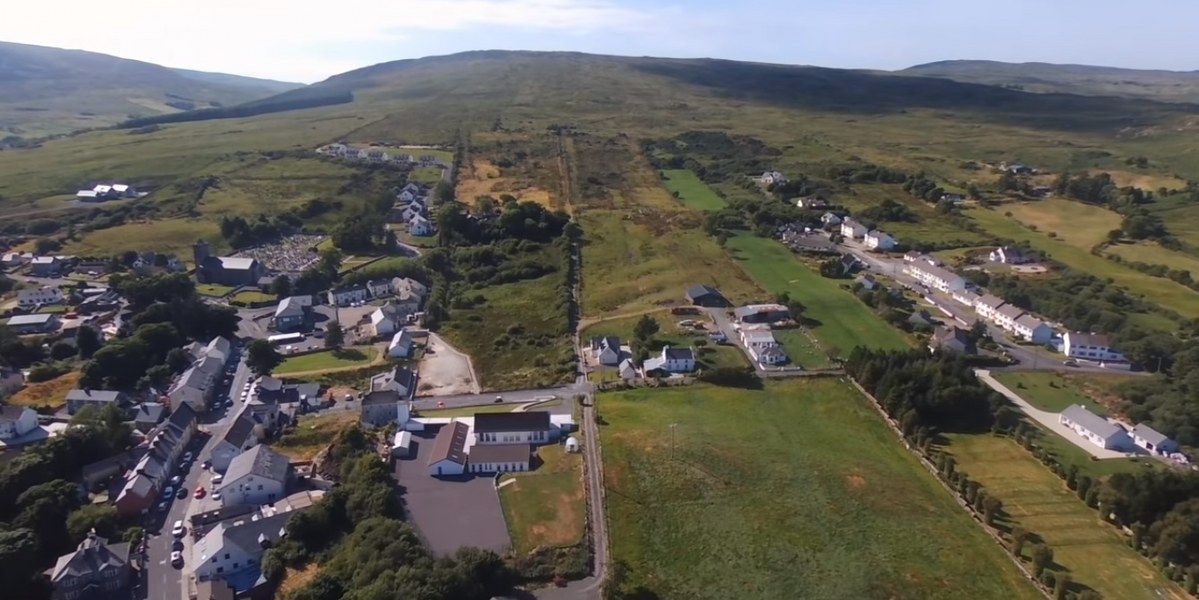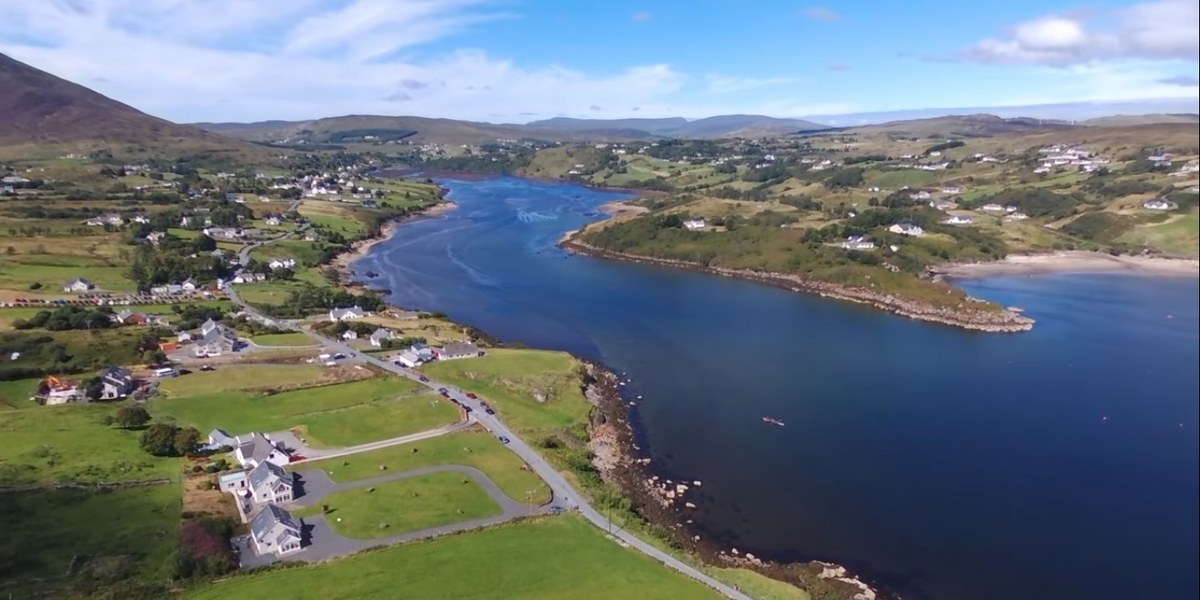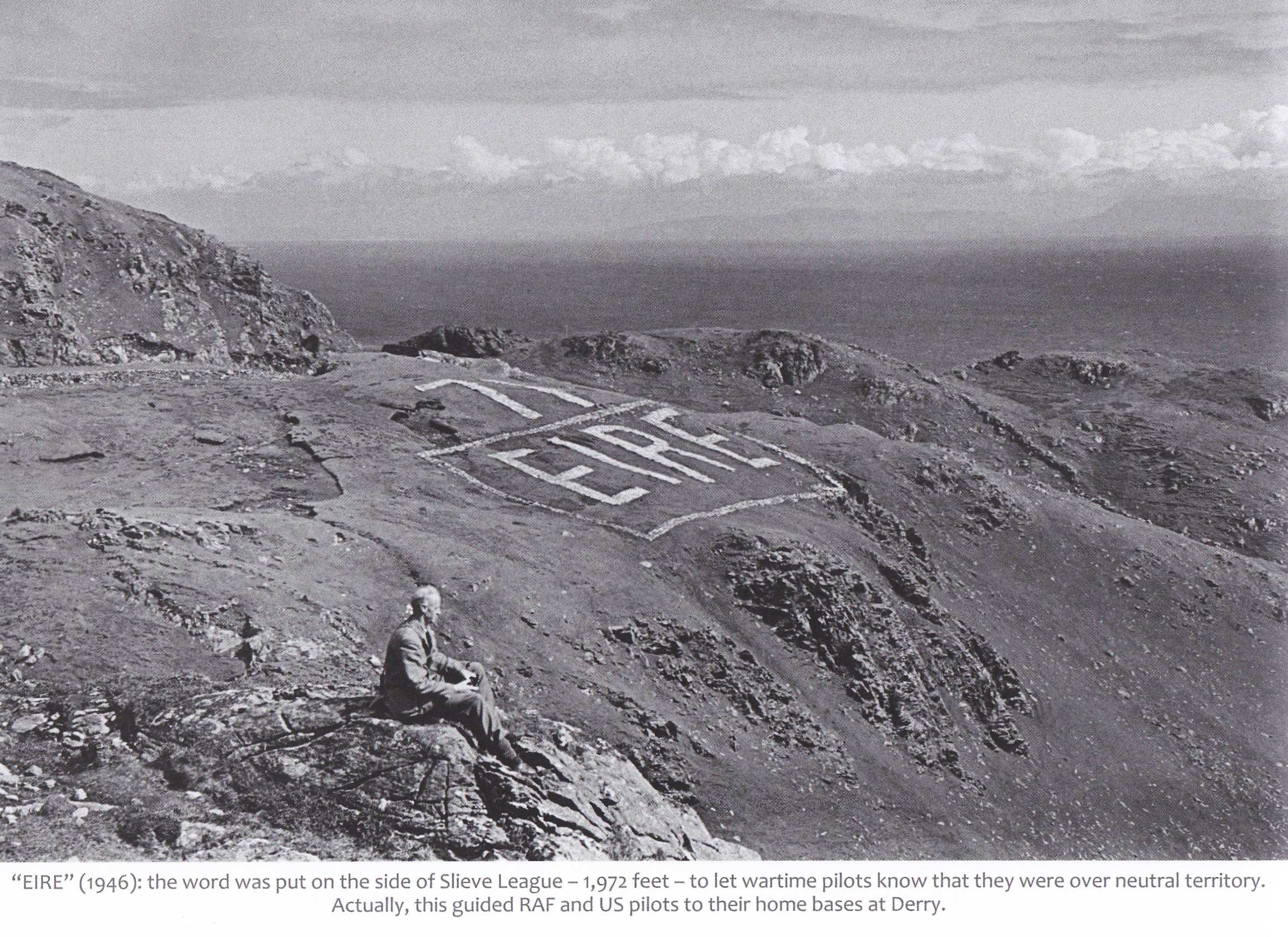
LOP 71 on Carrigeen Head by Joe Gallagher
This EIRE 71 Sign is on the road to Bunglas and near the Look Out Post on Carrigan Head. I found it on Page 62 of Father Browne's DONEGAL 2015. Father Browne was one of the two Jesuit Fathers who gave the Mission in Carrick and Glencolmcille in 1945? The LOP Sign was still in pristine condition as the War had just ended.
I found this Photograph (page 1) in Father Browne's Donegal 2015. The date given is 1946 but I think that it was taken in 1945. Fr. Browne was one of the two Jesuits who gave the Mission in Carrick and Glencolmcille in 1945. The Missioners stayed in Jim William Cunningham's house, Carrick. There are 30 Photographs of Teelin, Carrick and Glencolmcille in this book.
The Eire Aerial Markers near Look Out Posts were first laid out in 1939-40 to indicate to low flying aircraft that they were overflying the neutral Irish Free State. By 1944 the Americans were preparing for the D-Day Landings and they were flying Boeing B-29 Super-fortresses, which could fly at over 30,000 feet! The Irish government decided to enlarge the Eire Aerial Markers and David Grey, US Minister in the American Legation in Dublin insisted that the Number of the Local Look Out Post be added to the Aerial Markers. Thus, the Aerial Markers became Navigational Aids for the high-flying Aircraft. See pp 49, 244-252 of Guarding Neutral Ireland 2008 by Dr. Michael Kennedy.
The platoon that laid Aerial Marker 71 Eire was billeted in the house of Paddy and Frank Cassidy, Cappagh—three doors away from my home. The Officer in charge was Captain John (Sonny the Bell) Mac Loone from Glenties. Sonny's account of the work was: “When we were doing the painting of the Eire sign, we ran out of white paint. There was a `Phone call made to the British Army in Ennishkillen and they sent the white paint down to us the next day. That's how neutral we were in World War II!” Later when I thought about Sonny's story, an Event came back to my mind—we lived just three doors away from the Cassidy home in 1944. One evening while the Irish Army soldiers were billeted there, my father sent me over to Paddy and Frank with a message. I went to the back door and knocked. A genial well-built man came to the door and said, “Who is the big man that we have here?” I believe that that man was Sonny the Bell. Unfortunately, I never got to tell Sonny the story, as he died suddenly shortly afterwards!
The names of the Coast-watchers who served at LOP 71 Carrigan Head were : Corporal Michael (Hill) McNelis. Volunteers: Andy Byrne; D. Cunningham; Jimmie P. Donegan; Jimmy Lyons; Barney Maloney; James G. Mulloy; Paddy McGill; Paddy J. McLoughlin; Hugh McNelis; Paddy (Shisealla) McNelis; Paddy (Beag) McShane. I found the names in p. 325 : Guarding Neutral Ireland 2008 by Dr. Michael Kennedy.
Notes: The late Anthony McNelis told me that Paddy O'Donnell from Dungloe served on Carrigan Head. Paddy O'Donnell's son, Seán, confirms that. I note that a P. O'Donnell served at LOP 72 Rossan Point, Malinmore. I have not identified the D. Cunningham listed above—he may be the D. Cunningham listed on LOP 70, St. John's Point. When there was a man short at one Look Out Post, a member was taken from an adjacent LOP to make up a Crew.
The names of the Coast-watchers who served at LOP 72 Rossan Point: Corporal Colum M. Mockler. Volunteers: E. Boyle; H. Boyle; F. Cunningham; C. Kelly; C. Lyons; J. G. Mulloy; P. O'Donnell; P. O'Gara. I found the names in p. 325 : Guarding Neutral Ireland 2008 by Dr. Michael Kennedy.
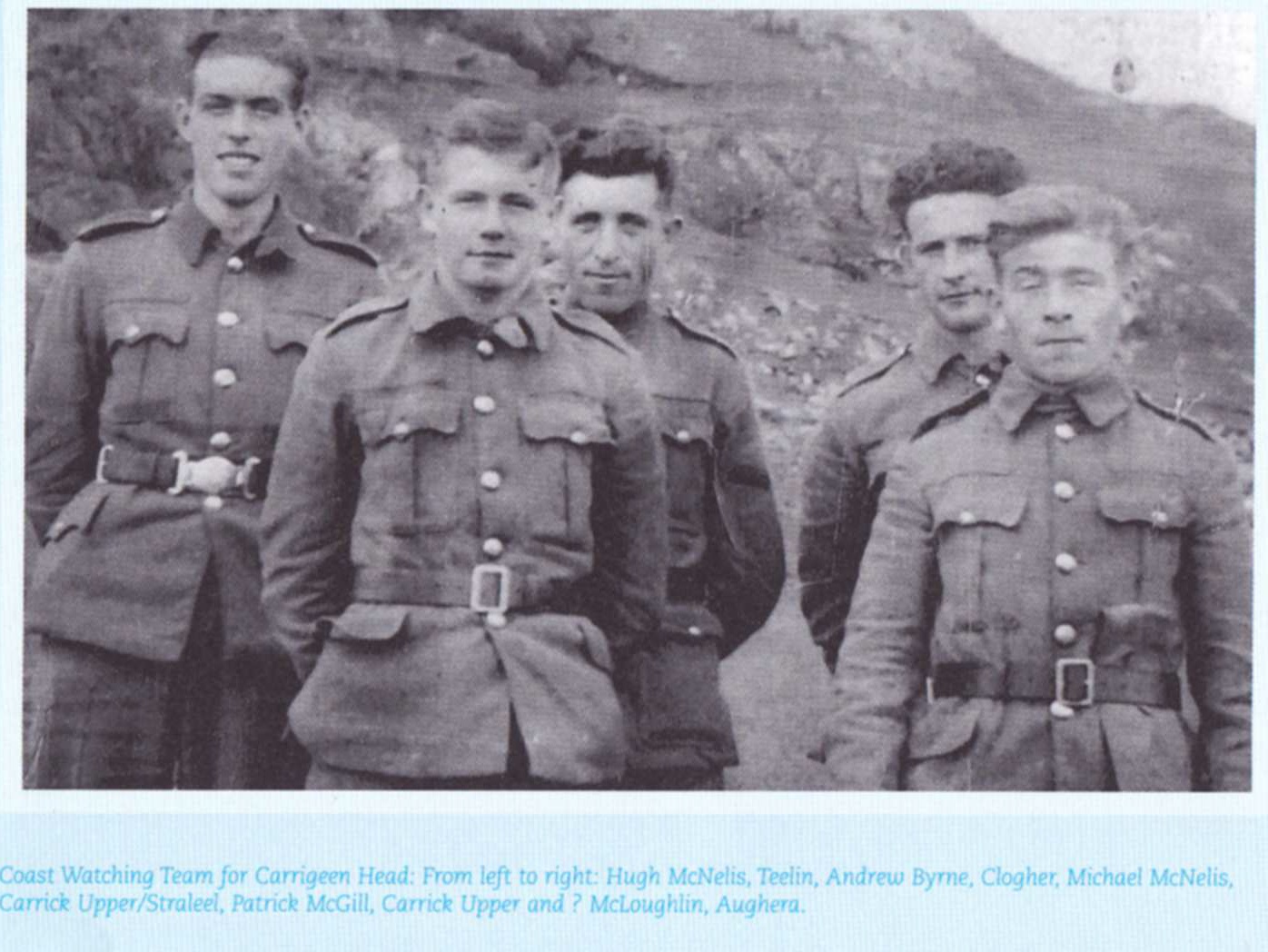
I found this Photograph in An Charraig—Carrick Reunion 2006. The full name of the man on the right is Paddy J. McLoughlin. Andrew Byrne died in America in 2015.
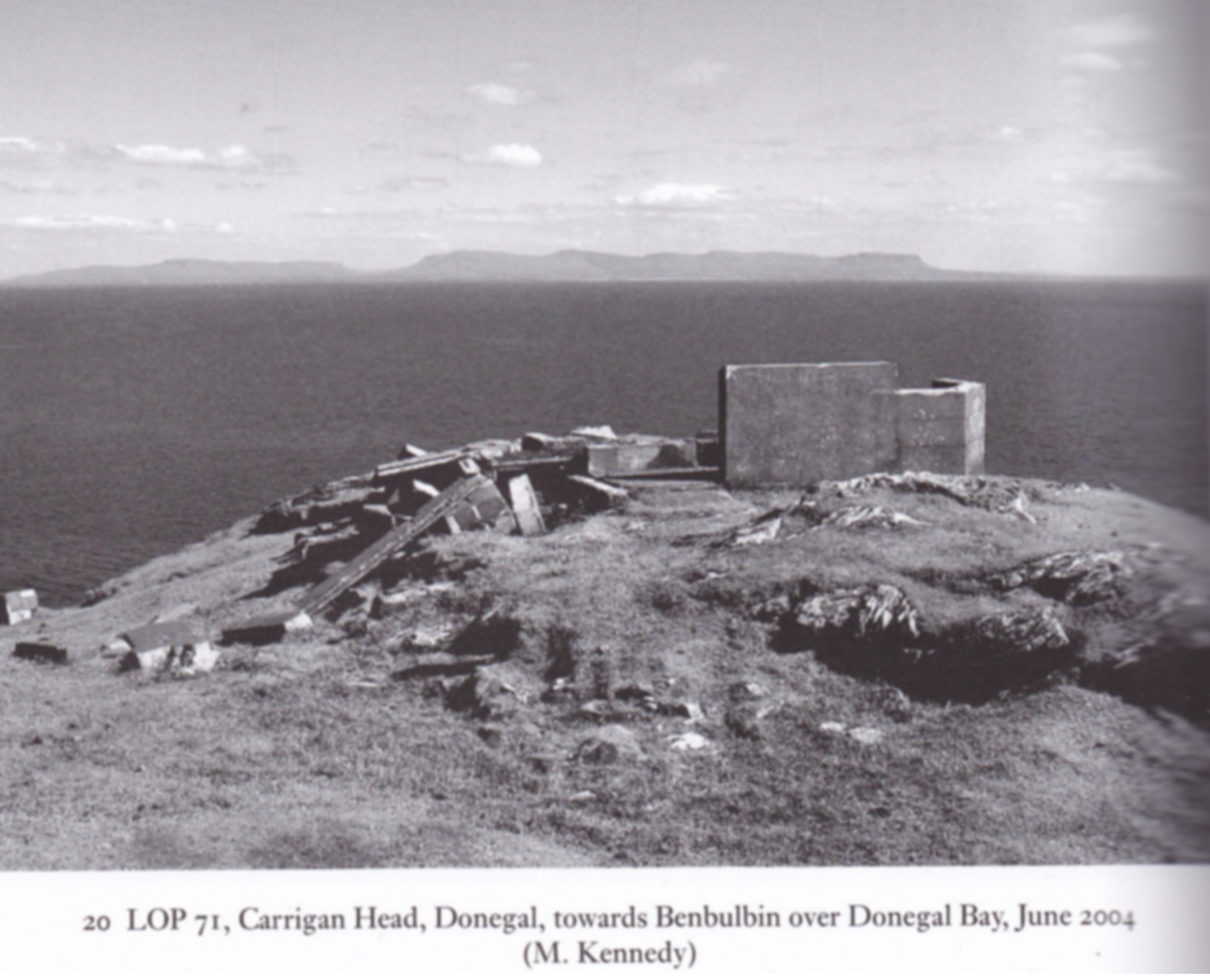
I found this Photograph of Carrigan Head in Guarding Neutral Ireland 2008 by Michael Kennedy.
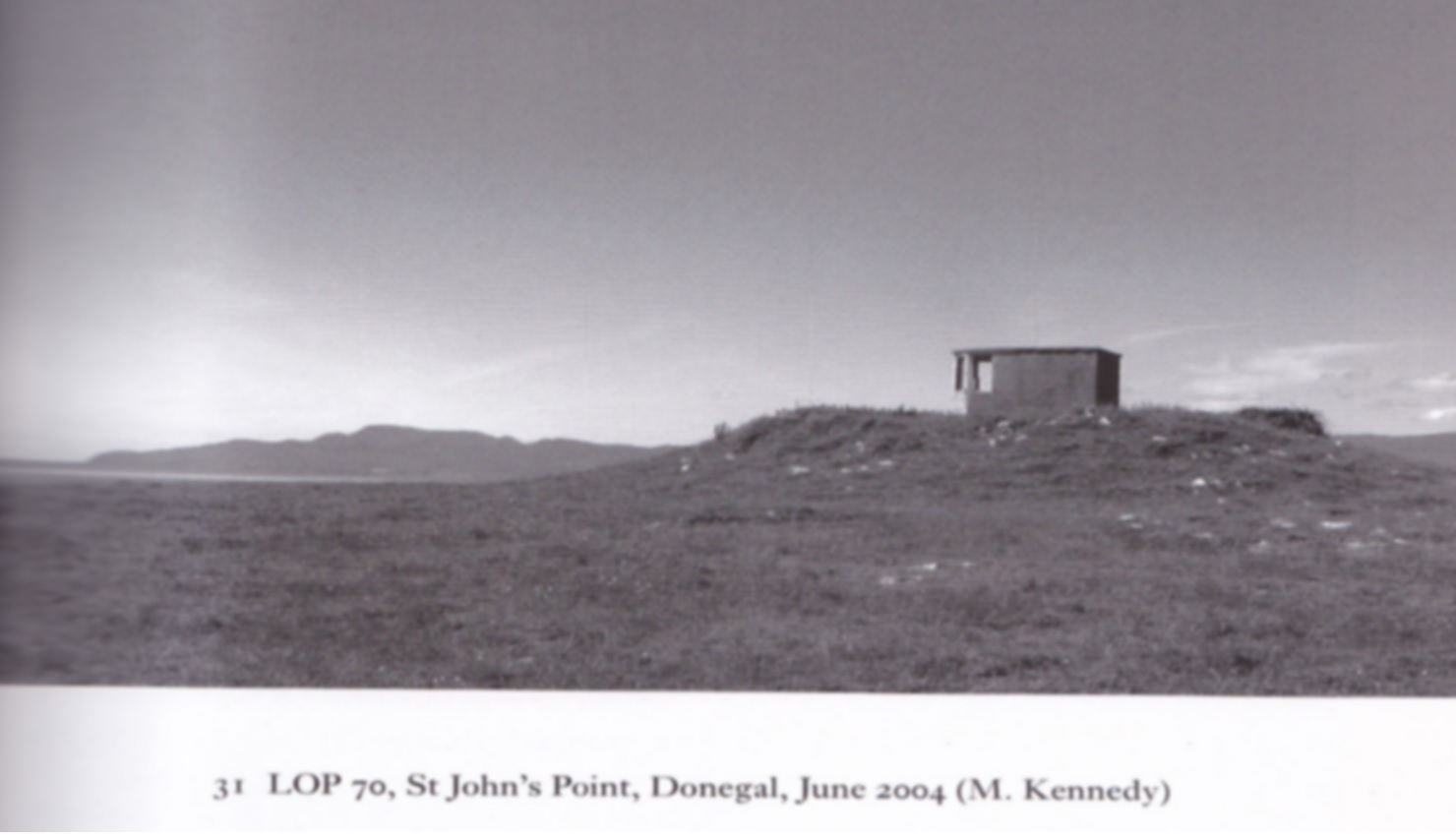
I found the above Photograph of St. John's Point in Guarding Neutral Ireland 2008 by Michael Kennedy. Note Teelin and Sliabh Liag in the Background.
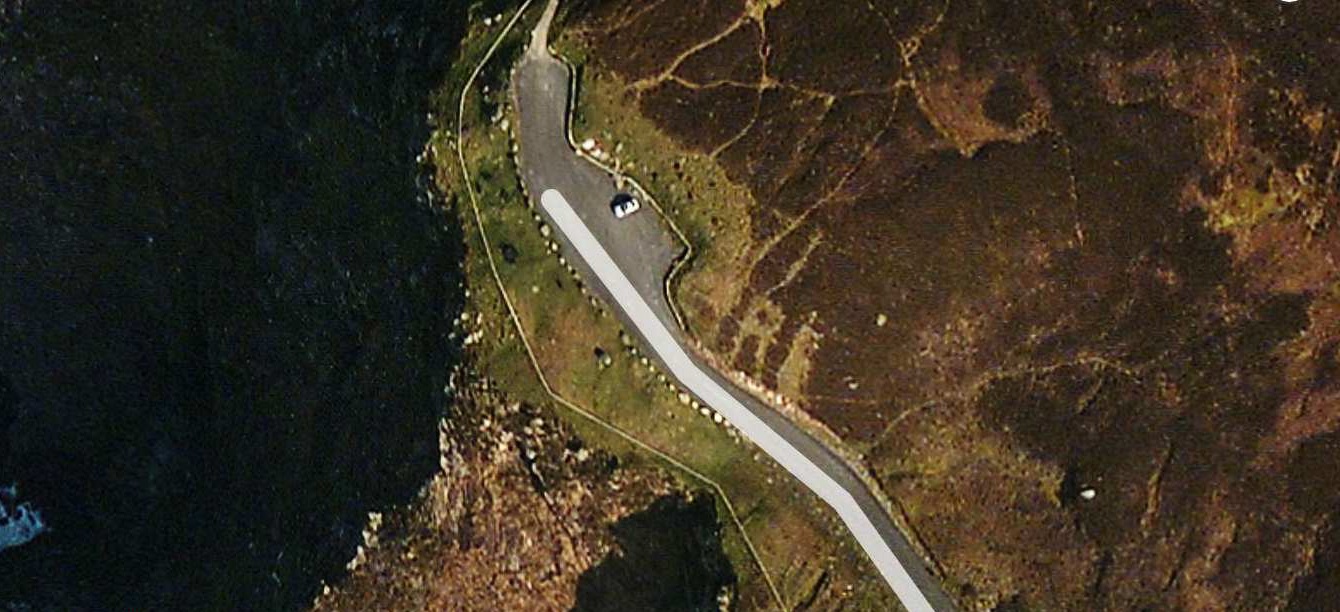
This is a recent Aerial Photograph of Bunglas Car Park area. In the centre of the photograph can be seen the remains of the original Carrigan Head LOP EIRE Sign?
This sign would have been made in 1939-40? I found this photograph on Website: http://eiremarkings.org/category/counties/donegal/

This is a Photograph of the Rossan Point Look Out Post Eire Sign 72. It is on the Ros Mór, Glencolmcille. The Sign can be seen to the left of centre of the photograph.
I don't know its exact position as I have not been wandering in that area for a long time (1951)! I found the photograph on Website: http://eiremarkings.org/category/counties/donegal/
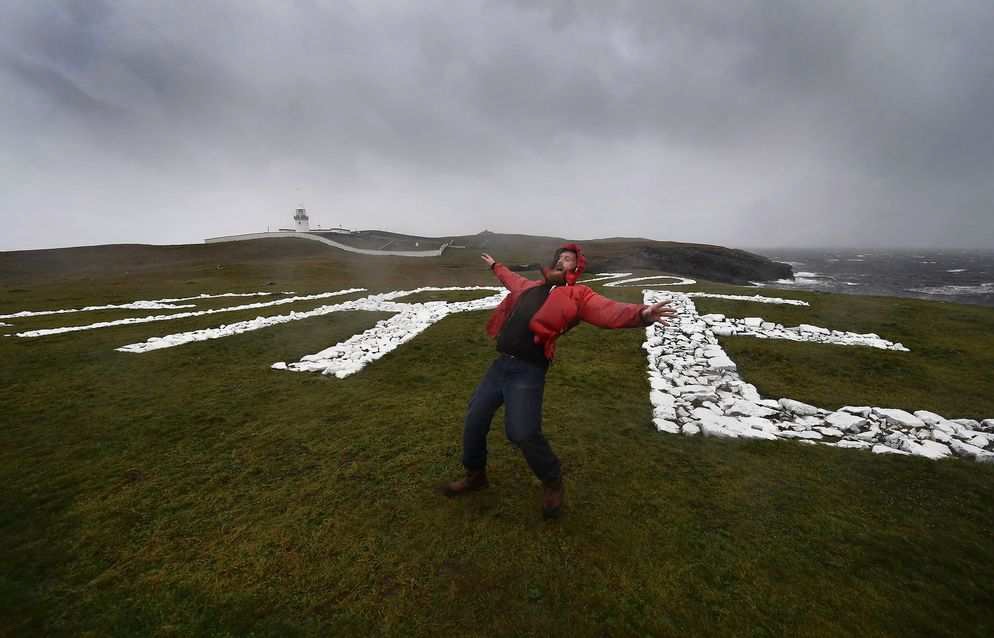
This is LOP 170, St.John's Point Co. Donegal. The Sign is newly painted and restored. The Photograph was taken on Ophelia Day.
I found the Photographon the Internet under Dunkineely! Hopefully, the Carrageen Head 171 LOP will be restored as a Tourist and Heritage attraction.
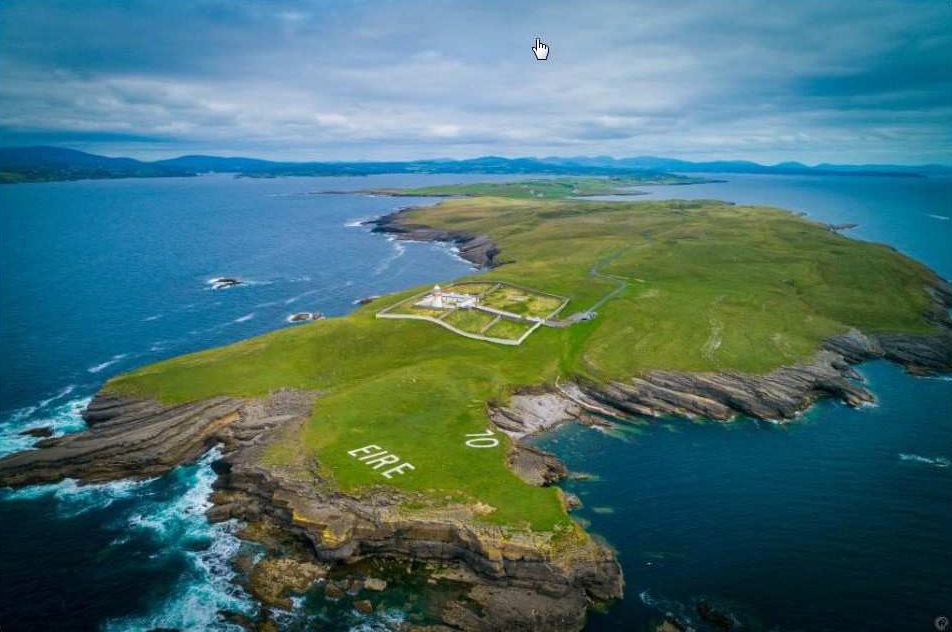
This is a recent aerial Photograph of St. John's Point, Co. Donegal. It shows the newly restored Lop Eire 70 Sign. Note that the roadway extends to the Lighthouse.
I found the Photograph on the website: eiremarkings.org. Conor Corbett took the Photograph.
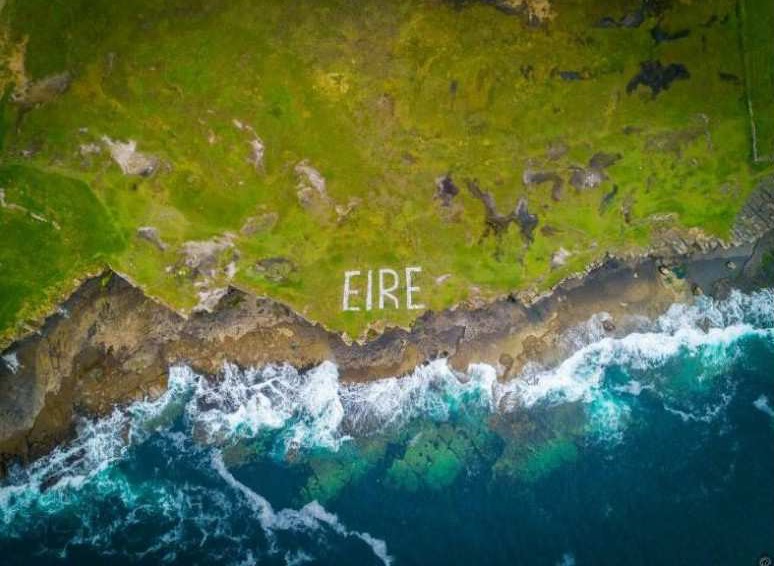
This is a Photograph of the LOP Sign on Mucros Head, Co. Donegal. This Sign was made in 1939-40. It was not enlarged in 1944 when LOP Sign 70 on St. John's Point
and LOP Sign 71 on Carrigan Head were enlarged. See notes on Page 2. I found the Photograph on website: eiremarkings.org
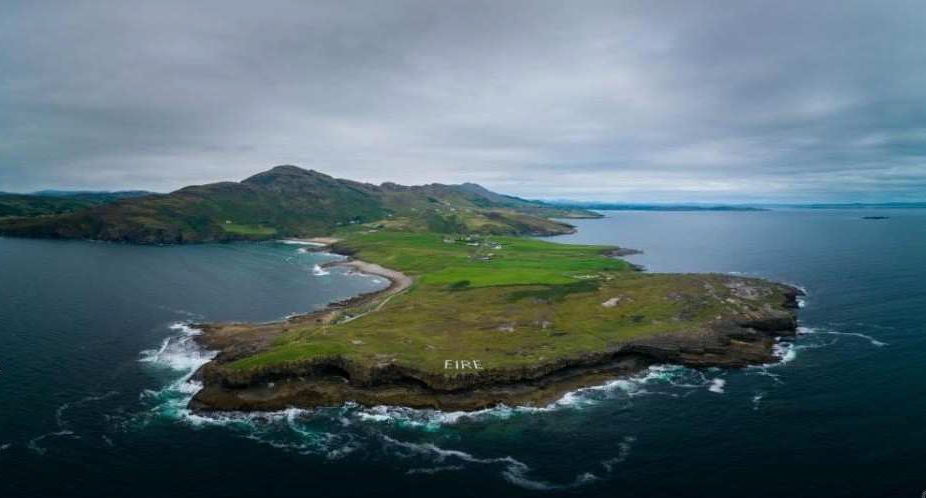
This is an aerial view of the Ros at Mucros showing the position of the Eire Sign. I found the Photograph on website: eiremarkings.org
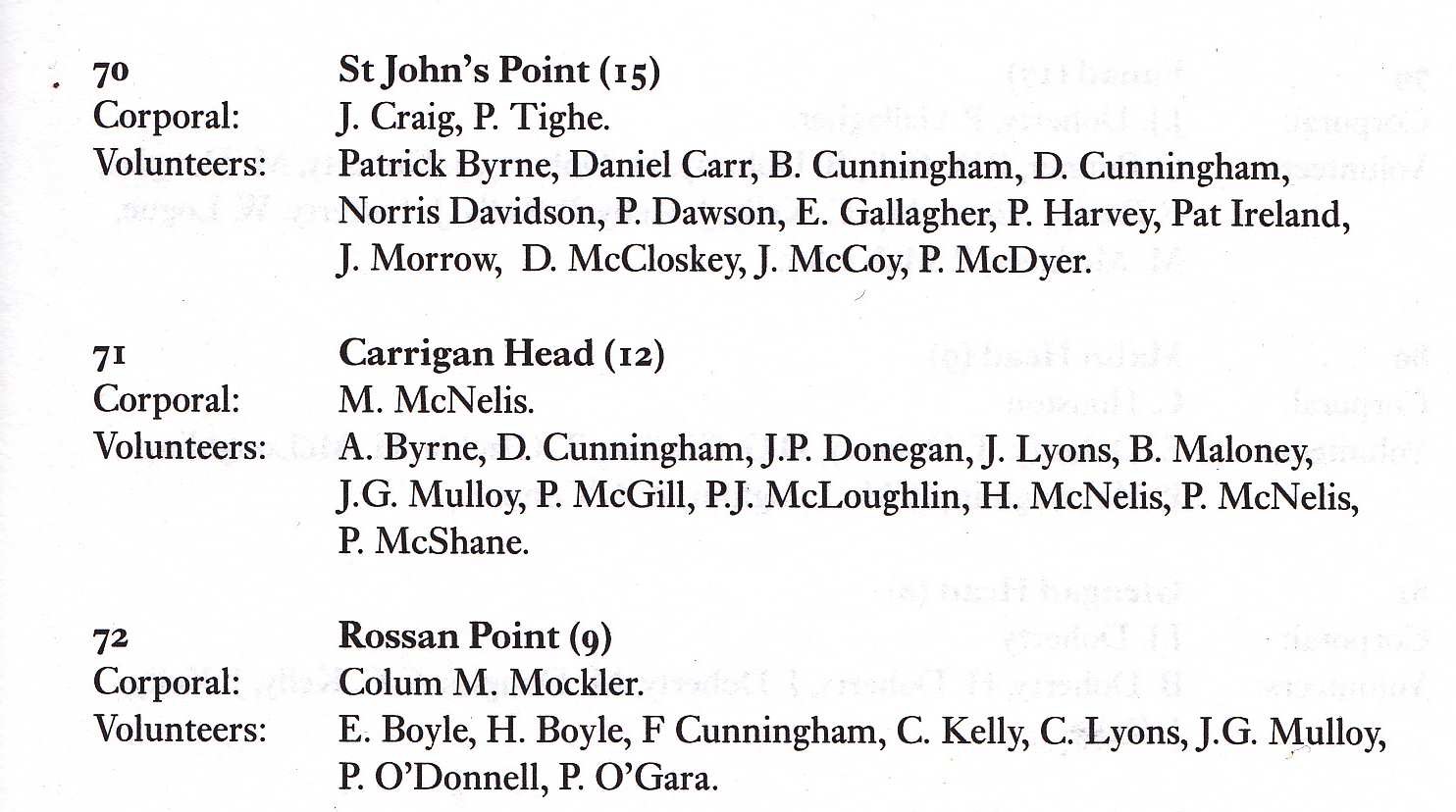
This is the list of the names of the Coast Watchers who served on LOP 70, St. John's Point; LOP 71, Carrigan Head; LOP Rossan Point. I found this list in Guarding Neutral Ireland 2008 by Michael Kennedy.
The Donegal corridor and the Battle of the Atlantic
From historyireland.com
As Europe fell to the advancing German armies in the early months of World War II, the United Kingdom became more and more isolated and increasingly dependent on the Atlantic trade route for industrial raw materials and food. Although some air cover was already provided, a gap existed in mid-Atlantic, a section which could not be reached from existing air bases. If U-boats could operate in this area without fear of air attack then Allied convoys would be at the mercy of German ‘wolf packs’.
As a result of aerial surveys carried out late in 1940 and despite a less than favourable report, construction of an RAF base began on the old Castle Archdale estate on the shores of Lough Erne with the intention of closing the gap. There was one snag. The extra 100 miles range possible from the new base would only become effective if the aircraft could fly due west over neutral Ireland. Failing an agreement, planes would have to fly north over Lough Foyle before heading for the Atlantic battleground.
While de Valera would not be coerced into joining the war, pragmatism demanded that, despite strained Anglo-Irish relations, an official blind eye be turned to what became known as the ‘Donegal corridor’, a route over south Donegal/north Leitrim/north Sligo and out to the Atlantic. This concession was subject to the provisos that flights would be at a good height and that the route over the military camp at Finner would be avoided, both of which conditions subsequently received scant attention from the British.
No. 240 Squadron, equipped with Stranraer flying boats, carried out the first sorties from the newly established base on Lough Erne, styled No. 15 Group Coastal Command, on 21 February 1941, thus bringing Fermanagh into the front line of the Battle of the Atlantic. One of the earliest and most notable successes was the location and chase that resulted in the sinking of the Bismarck. An entry in the Castle Archdale log for 27 May 1941 reads: ‘German battleship sunk at 11.00 hours. Aircraft of 209 and 240 squadrons operating from this station were responsible’.
The ‘nod and a wink’ policy of ‘neutral Ireland’ extended to more than just a shortcut to the Atlantic. Other concessions followed. The establishment in June 1941 of an armed air/sea rescue trawler, the Robert Hastie, manned by eleven British personnel, at Killybegs, Co. Donegal, was shrouded in secrecy. Its purpose was to provide assistance to shipping casualties and to supply planes that had run out of fuel. The need for such a vessel was illustrated the previous April when Pilot Officer Denis Briggs, returning from a routine U-boat patrol, was forced to ditch his Saro Lerwick sea-plane in the sea off Tullan Strand, near Bundoran, when he ran out of fuel. Watching the descent of the stricken plane, Irish army observation posts shortly afterwards beheld the unusual sight of an airplane being towed to Bundoran by a passing fishing-boat and immediately reported the incident to HQ. This was a new dilemma for all involved. Local units of the Irish Army, unaware of decisions made at a higher level, proceeded on the assumption that the crew would be interned for the duration of the war and the plane impounded. Following some hasty consultation and diplomatic manoeuvring, a camouflaged airforce lorry arrived from across the border with 80 gallons of aviation fuel. The plane was made ready and took off with its crew for their home base on Lough Erne.
On the evening of 5 December 1942 people from all over north Sligo looked up into a lowering winter sky, watching fearfully as a huge Flying Fortress circled noisily overhead looking for a safe place to land. ‘The Devil Himself’, as it was called, created a sensation when it dropped safely out of the sky onto Mullaghmore beach. The crew of American officers and airmen were fêted in the Beach Hotel, Mullaghmore, and at Finner camp for seventeen days while a replace-ment engine was supplied from Northern Ireland and fitted to the plane. A local man did well when he received £2 compensation from the Irish Air Corps for damage to his land!
Cooperation between the British and Irish authorities was soon commonplace, eventually becoming so close that in some instances HQ in Athlone could inform Castle Archdale of downed planes in Irish territory before the British even knew they were missing! There were approximately 162 wartime crashes or forced landings in southern Ireland. Below are others that occurred in the north-west:
24 January 1941, 17.00 hours, Lockheed Hudson reconnaissance bomber, RAF 233 Squadron, forced to land at Skreen, Co. Sligo (out of fuel). Repaired and flown to Baldonnell at 19.15 hours,26 March 1941. Four survivors, two missing. Two carrier pigeons taken into custody and sent to the Curragh!
21 March 1941, Catalina flying boat, 240 Squadron, Castle Archdale, crashed on the mountain near Glenade, Co. Leitrim. Nine dead, no survivors. The plane was completely wrecked.
30 April 1941, plane based at Limavady crashed at Askill, on Ballyshannon to Garrison road, Co. Donegal. Crew baled out safely.
21 July 1941, 19.00 hours, British Lockheed Hudson forced to land on Tragh Bui, Ballyconnell, Co. Sligo. Took off at 13.40 hours for Limavady. No casualties.
17 November 1942, 16.25 hours, Catalina flying boat en route from Bermuda to Scotland forced to land on Lough Gill, Co. Sligo. Crew of six unhurt. Refuelled and took off at 16.35 hours, 19 November 1942.
10 May 1943, 09.00 hours, B-17 Flying Fortress, 524th Bomb Squadron, en route from Gander, Newfoundland, to Prestwick, Scotland, forced to land (out of fuel) at Tullan Strand, Finner, Co. Donegal. Crew of ten unhurt. Aircraft dismantled and conveyed to Northern Ireland on low-loader.
9 December 1943, 17.19 hours, B-25 Flying Fortess, en route from Goose Bay, Canada, to Prestwick, crashed on Truskmore Mountain, Ballintrillick, Co. Sligo. Three dead, seven injured; plane a total wreck.
23 January 1944, 18.40 hours, British Halifax bomber struck cliff at Fairy Bridges, Bundoran, Co. Donegal. Completely wrecked; six bodies recovered, four washed out to sea.
31 January 1944, 23.30 hours, Sunderland flying boat DW 110, 228 Squadron, Castle Archdale, crashed at Bluestack Mountains near Brockagh, Co. Donegal. Seven killed, five injured.
20 February 1944, 18.10 hours, B-17 Flying Fortress forced to land (out of fuel) on Fintragh Strand, Killybegs, Co. Donegal. Plane submerged at high tide, becoming a total loss; ten injured.
5 May 1944, 09.15 hours, B24 US Liberator forced to land (out of fuel) at Carradreshy, Foxford, Co. Mayo. Crew of ten uninjured. Partially salvaged and handed over to RAF, Northern Ireland, on 1 June 1944.
19 June 1944, 22.50 hours, American Flying Fortress bomber forced down (engine failure) on the land of Hamilton Black, Sheegus, north-west of Ballyshannon, Co. Donegal. Two killed, seven injured, one unscathed. Plane badly damaged; handed over to US forces in Northern Ireland.
12 August 1944, 11.55 hours, British Sunderland, Squadron RCAF 422, Castle Archdale, crashed (engine failure) on Breesy Mountain near Belleek, Co. Fermanagh. Three killed out of crew of twelve. Surviving three engines and rear turret handed over to RAF in Northern Ireland.
4 September 1944, 21.00 hours, British Swordfish torpedo and reconnaissance biplane forced to land at Carrowcastle, Skreen, Co. Sligo. No injuries. Stephen Foley’s hen house destroyed, thirty chickens killed and half an acre of cabbage ruined! Plane dismantled and handed over to RAF in Northern Ireland, 10 September 1944.
17 December 1944, 16.20 hours, British Martinet, Squadron 131, forced to land on Classiebawn estate, Mullaghmore, Co. Sligo. No injuries. Wreckage salvaged and transferred to RAF in Northern Ireland by low-loader, 21 December 1944.
14 March 1945, 02.30 hours, British Sunderland, 201 Squadron, crashed on Fintragh Mountain, Clane, Killybegs. Crew of twelve killed; plane completely wrecked.
9 February 1945, 16.30 hours, British Halifax bomber forced to land in sea one mile east of Mullaghmore Head, Co. Sligo. Four survived, two drowned; one body recovered at Rossnowlagh and one at Mountcharles, Co. Donegal. Privates Herrity and Gilmartin of Mullaghmore commended on prompt reporting to Killybegs lifeboat, resulting in rescue of survivors.
Joe Mc Gowan is a local historian living in Mullaghmore, County Sligo and author of Constance Markievicz: the people’s countess.
